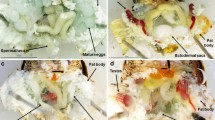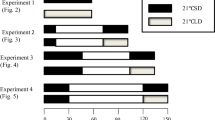Abstract
In temperate climates, the initiation and termination of diapause synchronize the stress-tolerant stage with the stressful season and reproduction with the non-stressful season in many insects. Synchronization is often regulated by photoperiodism.
Voltinism and the ultimate size of adults are also important determinants for their lifecycle, and different diapause stages and voltinism patterns are known in crickets.
Here, we investigated the life history of the African cricket Gryllus argenteus from Malawi, which is a typical arid tropical highland. The climate is characterized by alternating arid and wet seasons, each of which lasts for half a year, and where the available heat mass is much less than lowlands at the same latitude. We first measured the nymphal duration at each rearing temperature and calculated the lower developmental threshold (t 0) to be 20.19 °C based on Ikemoto and Takai (2000) and 19.38 °C based on a conventional line-fitting method. These values are very high relative to many other insects. The local temperature in winter does not fall below 15 °C, but this is much higher than the lethal limit. This suggested that critical stress in this locality was not coldness but low precipitation in winter. We estimated, based both on local temperature change and the Ikemoto and Takai’s t 0, that G. argenteus required 3 years to complete its lifecycle unlike wet lowland species, where univoltinism or multi-voltinism are commonplace. Photoperiodism was observed in this species, but due to a lag between annual cycles in photoperiod, temperature, and humidity, photoperiodism alone cannot atune their lifecycle with local conditions.
Synchronization in this species was achieved by three different adaptations: photoperiodism, high t 0, and large body size, which give it a long lifecycle. Although the species cannot achieve a univoltine lifecycle because of its high t0 value, it can escape from dry season by entering diapause at moderate temperatures, probably thereby achieving adaptive synchrony of lifecycle with both favorable and unfavorable seasons. A comparison between a conventional photothermogram and a newly formulated photohydrogram or photohygrogram demonstrates that even though sufficient heat is available, scarcity of water and thus scarcity of foliage should force the cricket to maintain diapause at intermediate temperature. The results suggested that high t 0, large body size, and multi-ennial lifecycle mutually affect each other and formulate a unique adaptation under such an extreme environment.










Similar content being viewed by others
References
Alexander RD (1968) Life cycle origins, speciation, and related phenomena in crickets. Q Rev Biol 43(1):1–41
Behrens W, Hoffmann KH, Kempa S, Gäßler S, Wallner GM (1983) Effects of diurnal thermoperiods and quickly oscillating temperatures on the development and reproduction of crickets, Gryllus bimaculatus. Oecologia 59:279–287
Bodenheimer (1927) Über Regelmäßigkeiten in dem Wachstum von Insekten. I Das Längenwachstum Berliner entomologische Zeitschrift 1:33–57
Brown VK (1978) Variations in voltinism and diapause intensity in Nemobius sylvestris (Bosc.) (Orthoptera: Gryllidae). J Nat Hist 12:461–472
Clifford HF (1970) Analysis of a northern mayfly (Ephemeroptera) population, with special reference to allometry of size. Can J Zool 48(2):305–316
Danks HV (1987) Insect dormancy: an ecological perspective. Biological survey of Canada
Denlinger DL (1986) Dormancy in tropical insects. Annu Rev Ent 31:239–264
Fischer J (1974) Experimentelle beiträge zur Ökologie von Chironomus (Diptera). I Dormanzbei Chironomus nuditarsis und Ch plumosus. Oecologia 16(1):73–95
Fuzeau-Braesch S (1963) Ajustement du cycle de vie avec les saisons chez un insectunivoltin. C r hebd Sèanc Acad Sci, Paris 256(3):792–794
Hanna HM, Hamad NEF, Azab SG (1981) Effect of photoperiod on thebiology of the lesser cotton leaf worm Spodoptera exigua. Bull Soc ent Egypte 61(1977):215–224
Honek A and Kocourek F (1990) Temperature and development time in insects: a generalrelationship between thermal constants
Ikemoto, Takai (2000) A new linearized formula for the law of total effective temperature and the evaluation of line-fitting methods with both variables subject to error. Environ Entomol 29(4):672-1–67682
Ingram BR, Jenner CE (1976) Influence of photoperiod and temperature on developmental time and number of moults in nymphs of two species of Odonata. Can J Zool 54(12):2033–2045
Kiritani K (1997) The low developmental threshold temperature and the thermal constant in insects, mites and nematodes in Japan. Miscellaneous Publication of the National Institute of Agro-environmental Sciences 21 (in Japanese)
Masaki S (1961) Geographic vatiations of diapause in insects. Bull Fac Agric Hirosaki Univ 7:66–98
Masaki S (1972) Climatic adaptation and photoperiodic response in the band-legged ground cricket. Evolution 26(4):587
Masaki S, Ohmachi F (1967) Divergence of photoperiodic response and hybrid development in Teleogryllus (Orthoptera: Gryllidae). Kontyu 35:83–105
Masaki S, Walker TJ (1987) Cricket life cycles. Evol Biol 21:349–423
Murai T and Ito F (2011) A guidebook of Japanese grasshoppers, crickets and katydids. Hokkaido University press. (in Japanese)
Okamoto D, Akino K, Sasaki M (1956) Bionomics and control by aldrin of Gryllotalpa africana Palisot de Beauvois. Nogyo Oyobi Engei 31:569–572
Tanaka S (1983) Seasonal control of nymphal diapause in the spring ground cricket, Pteronemobius nitidus (Orthoptera : Gryllidae). Insect life-cycle polymorphism
Tanaka S, Denlinger DL, Wolda H (1987) Daylength and humidity as environmental cues for diapause termination in a tropical beetle. Physiol Entomol 12:213–224
Utida S (1957) Developmental zero temperature in insects. Bull Appl Entomol Zool (Jpn) 1(1):46–53 (in Japanese)
Watanabe M, Kikawada T, Minagawa N, Yukuhiro F, Okuda T (2002) Mechanism allowing an insect to survive complete dehydration and extreme temperatures. Exp Biol 205:2799–2802
Acknowledgements
Special thanks are due to Mr. Shinnichiro Dai (deceased) for collecting this cricket, which was allowed to be reared in the laboratory by special permission of the Plant Quarantine Service, Ministry of Agriculture, Forestry and Fishery. We thank Dr. Seiji Tanaka for critically reading this manuscript and Mr. Akihiko Ichikawa for identifying the species. This is dedicated to the memory of late prof. Sinzo Masaki who was a pioneer to this field and a great teacher/scientist.
Author information
Authors and Affiliations
Corresponding author
Additional information
Communicated by: Sven Thatje
Rights and permissions
About this article
Cite this article
Kosumi, T., Takeda, M. Three-year lifecycle, large body, and very high threshold temperature in the cricket Gryllus argenteus for special adaptation to desiccation cycle in Malawi. Sci Nat 104, 70 (2017). https://doi.org/10.1007/s00114-017-1488-y
Received:
Revised:
Accepted:
Published:
DOI: https://doi.org/10.1007/s00114-017-1488-y




